Referred Pain From The Thoracic Spine
Get Help With Referred Pain From The Thoracic SpinePain is the body’s way of signalling distress or injury. But what if your body manifests pain in a certain area of your body and yet the actual source of the discomfort is a completely different part of your body?
In this article, we will explore the intricacies of referred pain, specifically referred pain from the thoracic spine. We’ll explore what this typically feels like, what conditions commonly cause referred pain, and the treatment options available to treat the root cause of this symptom.
What Is Referred Pain?
Referred pain is pain that is perceived or felt in a location that is different from the actual site of tissue damage/injury. The classic example is that of a patient who is having a heart attack. The tissue injury is occurring in the heart, but a patient may only feel pain or discomfort in their arm or jaw. In this example, the pain and tissue injury of a heart attack is referred to the arm or jaw.
What Does It Feel Like?
Referred pain can vary widely, depending upon the individual, the source of the pain, and past medical history, including the presence or absence of central sensitization. Common examples include:
- Dull ache or throbbing
- Radiating or traveling sensation
- Deep discomfort
- Widely distributed pain
- Triggered by movement or pressure
- Absence of tenderness in the referred area
Common Conditions Associated With Referred Thoracic Pain
The thoracic spine is composed of many different structures that are susceptible to degeneration and injury. These include the facet joints, intervertebral discs, vertebral bodies, ligaments, nerves and spinal cord.
Injury to any of these structures can cause pain that is localized to the involved structure or that is perceived in an area different from that of the tissue injury (referred pain).
For example, a herniated disc may cause debilitating pain at the level of the disc or can elicit pain in an area that is away from the actual site of tissue injury such as the abdomen. This is known as referred pain.
Thoracic Facet Joint Pain
A facet joint is a small, paired joint in the back of the spine that provides stability and limits excessive movement. There is a facet joint at each level of the spine, one on the right and one on the left. They are labeled according to their level in the spine. For example, the first thoracic facet joint occurs at the T1/2 level.
Like the knee and hip joints, a facet joint is lined with cartilage and enveloped by a fibrous capsule. Facet joints are susceptible to degeneration and injury. Thoracic facet joints have distinct referral patterns, as seen in the figure below.
Unfortunately, there is a significant overlap between some of the thoracic facet joints.1
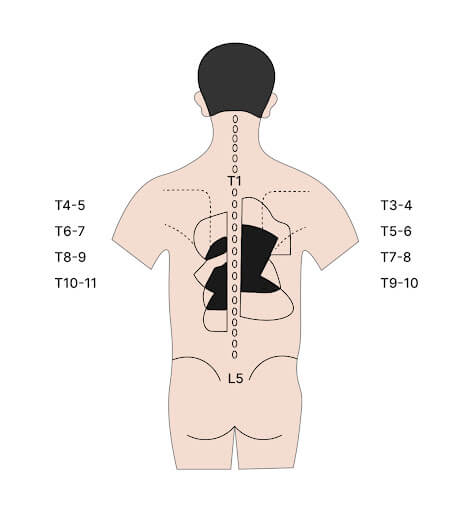
Thoracic Costotransverse Joint Pain
The costotransverse joint is a unique joint, as it occurs only in the thoracic spine. It is formed by the union of the rib and the transverse process of the spine. Like the facet joints, it is lined with cartilage and surrounded by a thick capsule. The costotransverse joint allows for gliding and rotation of the rib head during breathing.
These joints are susceptible to degeneration and injury. The costotransverse joints have distinctive referral patterns.2
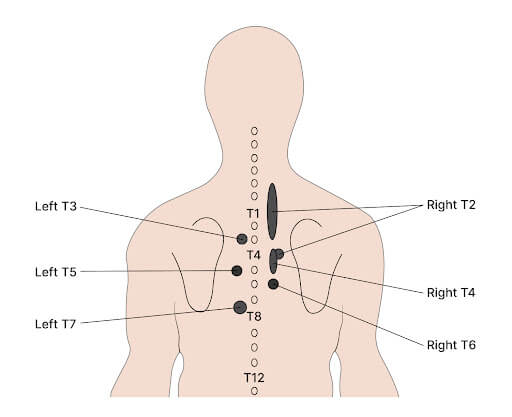
Thoracic Interspinous Ligaments
Ligaments are thick pieces of connective tissue that provide support and stability. Think of them as duct tape for the human body. The spinous processes are the large protruding bones on the backside of the spine.
With my children, I refer to them as the dinosaur bones. There is a spinous process at each level of the spine.
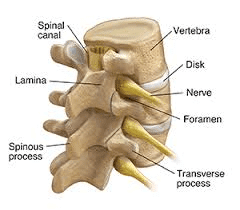
A series of ligaments span between each spinous process. The most important ligaments are the supra and interspinous ligaments.
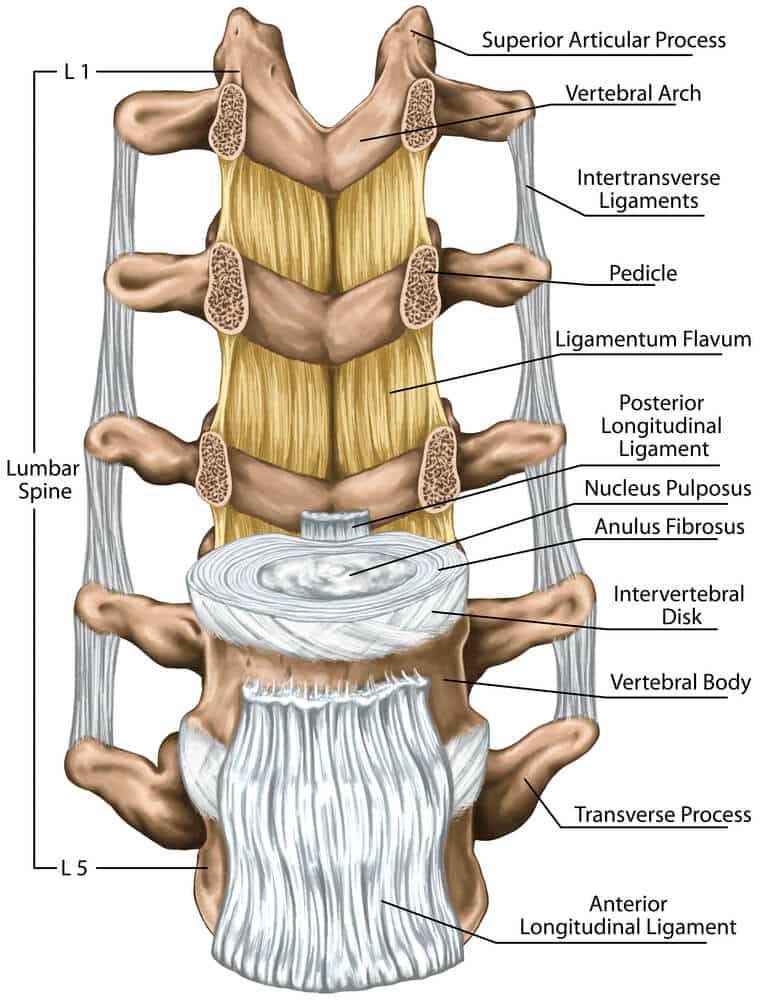
The interspinous ligaments are susceptible to injury and degeneration. Like thoracic facets and costotransverse joints, the thoracic interspinous ligaments have known referral patterns.
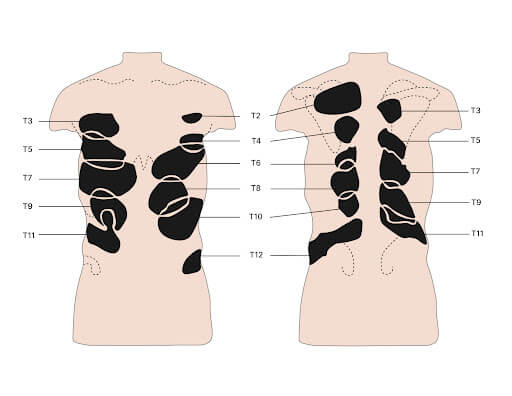
Thoracic Degenerative Disc Disease
Thoracic discs are important shock absorbers that are sandwiched between the boney building blocks in the spine. They are labeled according to the two building blocks they are sandwiched between. For example, the first disc in the thoracic spine is the T1/2 disc as it is situated between the T1 and T2 vertebral bones.
Thoracic discs are susceptible to injury and degeneration. Common examples include a disc protrusion, disc herniation, annular tear or extrusion. These injuries can produce localized pain or pain that is referred.
Thoracic Radiculopathy
Thoracic radiculopathy is a medical condition that occurs due to irritation or compression of one or more thoracic nerves as they exit the spine. The compression can lead to pain, tingling, numbness or weakness that radiates along the path of the affected nerve. For example, compression of the T1 nerve can be referred to the inside aspect of the forearm.
Nerve irritation or compression can occur due to disc injury, facet overgrowth, bone spurs, thickening of ligaments or slippage of the vertebral body.
Bulging Disc In Thoracic Spine
A bulging disc in the thoracic spine is a serious medical condition that occurs when the outer layer of the disc weakens, causing it to bulge outward and put pressure on nerves and the spinal cord. The disc has two components, a soft center and a thick outer layer, and weakening or tears in the outer layer can lead to a bulge. Symptoms include pain, numbness, and weakness in the affected area. The thoracic spine is that portion of the spine that resides below the neck and above the low back. It is commonly referred to as the mid-back. A bulging…
Read More About Bulging Disc In Thoracic SpineHerniated Thoracic Disc
A herniated thoracic disc is especially difficult because there are not as many treatments available as there are for disc herniations in other areas of the spine. To understand Thoracic Disc Herniations, though, we first need to cover thoracic spine anatomy and function. With disc herniation, the annulus fibrosus get small tears throughout the annulus. An annulus is a bunch of concentric fibers, so, as the fibers get damaged and cut, the pressure that is built up within the nucleus pushes the now weakened annulus outward, creating a bulge or herniation. The disc begins to weaken via mild degeneration/tearing of the annular fibers…
Read More About Herniated Thoracic DiscLesions on Thoracic Spine
The evaluation of the lesion in the thoracic spine involves many steps. The first step is a detailed medical history where the following is documented: onset of symptoms, duration, location, intensity, aggravating and alleviating factors, and treatment to date. Physical Examination: Evaluation of range of motion, area of tenderness, motor strength, sensation to pinprick, and detailed neurologic examination. Radiographic Studies: Radiographic tests are essential and may include:X-ray: Low-cost and readily available, X-rays provide an image of the bones and can reveal fractures, dislocation, osteoporosis, and deformities like scoliosis and kyphosis. It is often the first-line diagnostic tool used to evaluate spinal conditions. Low amount…
Read More About Lesions on Thoracic SpineThoracic Cyst
Cysts are abnormal, closed sacs that contain fluid, gas or semi-fluid material. They can develop in various parts of the body. They can vary in size from very small to large and can be located within organs, tissues or bones. Cysts can be either benign (non-cancerous) or malignant (cancerous). Most cysts are benign. They occur due to a number of different reasons that include obstruction, infection, chronic inflammation, instability or cellular abnormalities. So, thoracic spine cysts are abnormal, closed sacs that occur in the spine below the neck and above the low back.
Read More About Thoracic CystThoracic Radiculopathy
Thoracic radiculopathy is a painful medical condition that affects both men and women alike. Pain, paresthesia, decreased sensation, and weakness are the major symptoms. Radiculopathy refers to the whole complex of symptoms that can be caused by irritation or compression of a nerve root in the spine. Thoracic radiculopathy is irritation or compression of a thoracic spinal nerve. Causes of radiculopathy in the thoracic region are thoracic disc injuries, thoracic facet arthritis, ligament thickening, facet cyst, unstable rib attachments, and bone spurs. Diagnosis of thoracic radiculopathy can be difficult….
Read More About Thoracic RadiculopathyThoracic Spine Arthritis
Osteoarthritis is a common type of arthritis. It is a degenerative joint disease that principally affects the cartilage in your joints. Cartilage is the slippery connective tissue that covers the ends of bones that form joints, and it allows for smooth, effortless movement. Osteoarthritis involves the breakdown of the cartilage with subsequent pain, swelling, and reduced range of motion. The thoracic spine is that section of the spine that is below the neck and above the low back. It is often referred to as the “mid-back.” Thoracic spine arthritis involves the breakdown of the cartilage in joints within the thoracic spine.
Read More About Thoracic Spine ArthritisThoracic Spine Hemangioma
Hemangiomas are benign tumors composed of abnormal blood vessels. They can occur anywhere in the body but most commonly appear on the face, scalp or back. They can also occur in the vertebral bodies in the spine where they are referred to as vertebral hemangiomas. The vertebrae are the boney building blocks that stack one upon another that make up the spine.
Read More About Thoracic Spine HemangiomaThoracic Spondylosis
The thoracic spine, also known as the mid back, is that portion of the spine that is below the cervical spine (neck) and above the lumbar spine (low back). Thoracic spondylosis is a degenerative condition of the thoracic spine. The thoracic spine, also known as the mid back, is composed of many important different structures that work together to provide stability and movement. Thoracic spondylosis is a degenerative condition affecting the middle region of the spine, known as the thoracic spine. The major causes include: aging, genetics, poor posture, repetitive strain, and more. Symptoms can be mild, moderate, or severe…
Read More About Thoracic Spondylosis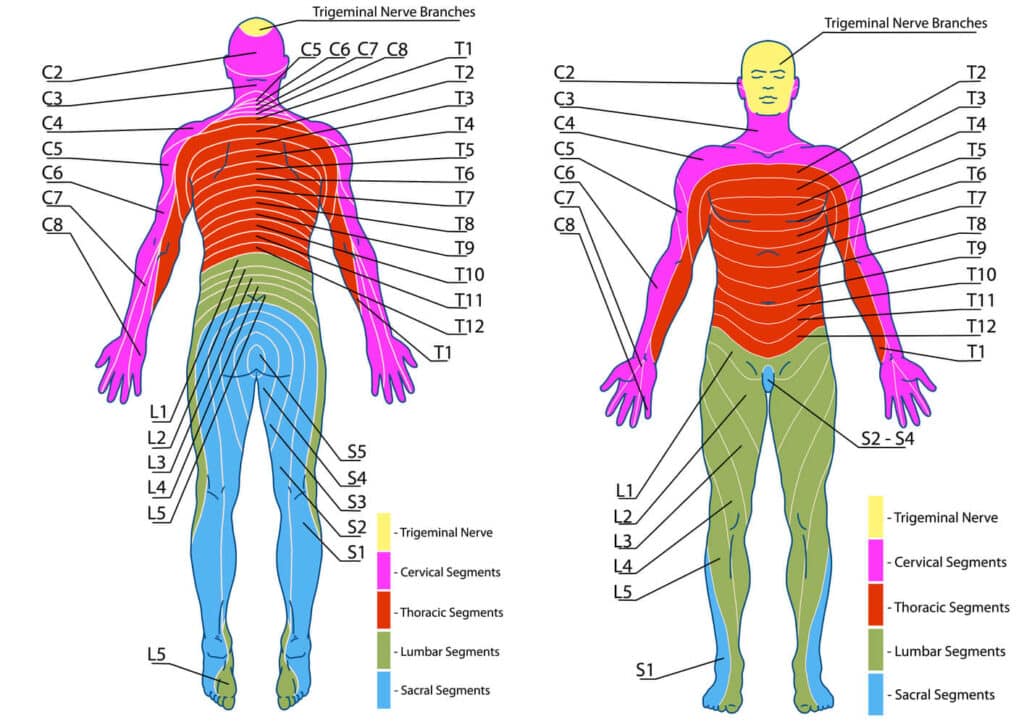
How Is Referred Pain In The Thoracic Spine Diagnosed?
Diagnosis of referred pain in the thoracic spine requires multiple steps. An accurate diagnosis is essential for best clinical outcomes. Treating symptoms without understanding and identifying the underlying cause of the pain can be frustrating, with mediocre results at best.
- Medical history: A detailed medical history will include onset of symptoms, aggravating and alleviating factors, location, severity of pain, type of pain, treatment to date, past medical and surgical history, current medications and allergies.
- Physical examination: A physical exam will include inspection, palpation and a sensory examination and an evaluation of range of motion, muscle strength, reflexes and neurologic strength.
- Imaging tests: Radiographic studies are an integral part of the evaluation and diagnosis of referred pain. X-rays are useful for identifying disc locations, fractures and bony abnormalities.
MRI is a powerful modality that uses strong magnetic fields and radio waves to create detailed 3D images of the body. Unlike X-rays, MRIs provide detailed images of both bone and soft tissue such as thoracic discs, facet joints, nerves, tendons, ligaments, muscles and the spinal cord.
MRI is the preferred radiographic study for evaluation of thoracic pain.
What Are The Conventional Treatments For The Pain?
When appropriate, conservative care should always be the first line of treatment. This would include the following:
- Dietary supplements: Studies have shown that seven dietary supplements can help reduce pain from arthritis, namely collagen hydrolysate, passion fruit peel extract, Curcuma longa extract, Boswellia serrata extract, curcumin, pycnogenol, and L-carnitine.1
- NSAIDs: NSAIDs are powerful anti-inflammatory agents. Common examples include ibuprofen, naproxen, Voltaren and Celebrex. They are available in both tablets and topical creams. They have significant side effects, which have been previously discussed, and should be avoided.
- Oral narcotics: Narcotics are powerful medications to reduce pain and increase function. They have significant side effects, which include dependence, and therefore should be avoided. Furthermore, they do NOT address the underlying problem or tissue injury. Rather, they simply mask the pain.
- Corticosteroids: Corticosteroids are a type of medication that reduce inflammation and immune responses. They do so by inhibiting transcription factors that control the synthesis of pro-inflammatory mediators such as macrophages, eosinophils, lymphocytes, mast cells, and dendritic cells.
They also inhibit phospholipase A2, which produces numerous inflammatory mediators.
Common examples include prednisone, betamethasone, dexamethasone and “oral dose pack”. Corticosteroids can be taken orally or injected into muscle or directly into a targeted joint. Corticosteroids do NOT treat the underlying injury but rather treat the symptoms.
- Surgery: Thoracic surgery should be the option of last resort as there are no guarantees that the pain will improve. Surgery is associated with a significant number of complications that include bleeding, infection, failure, escalation in pain, nerve damage, spinal cord injury and death.
Common surgeries in the thoracic spine include:
- Laminectomy: removal of a section of bone on the backside of the spine to decompress a narrowed spinal canal. Oftentimes the stability of the thoracic spine is compromised due to the removal of the lamina, ligaments and tendons.
- Discectomy: removal of a section of the disc that is damaged or causing pain.
- Fusion: removal of one or more discs, replaced with spacers, bone graft and supported by rods and screws.
The Centeno-Schultz Regenerative Treatment Approach
At the Centeno-Schultz Clinic we are committed to providing an accurate diagnosis so that the best treatment plan can be designed and implemented. That means taking the time to secure a detailed medical and surgical history and performing a comprehensive physical examination and review of radiographic studies.
This does not mean simply reading the radiologist’s report. Rather, it means reviewing the actual study, scanning for abnormalities or injuries that could be responsible for the pain. Specific treatment options will depend upon the location of the injury, its size and whether adjacent tissue is irritated or injured. Treatment options include:
Prolotherapy Injections
It has been successful in the treatment of many disorders including neck, shoulder, knee, and ankle pain. Dr. Centeno recently published an article in The Journal of Prolotherapy in which he discusses the use of x-ray guidance with prolotherapy. This ensures that the injection is in the correct place to maximize clinical results. Dr. Centeno discusses the use of prolotherapy for the treatment of neck, knee, sacroiliac joint, ankle, ischial tuberosity, and shoulder pain. At the Centeno-Schultz Clinic x-ray guided prolotherapy is just one of the therapies utilized in the successful treatment of pain. Regenerative injection therapy (RIT) or prolotherapy…
Read More About Prolotherapy InjectionsPRP Injections
PRP is short for platelet-rich plasma, and it is autologous blood with concentrations of platelets above baseline values. The potential benefit of platelet-rich plasma has received considerable interest due to the appeal of a simple, safe, and minimally invasive method of applying growth factors. PRP treatments are a form of regenerative medicine that utilizes the blood healing factors to help the body repair itself by means of injecting PRP into the damaged tissue. In regenerative orthopedics, it is typically used for the treatment of muscle strains, tears, ligament and tendon tears, minor arthritis, and joint instability. There have been more than 30 randomized controlled trials of PRP…
Read More About PRP InjectionsBMAC Injections For Cervical Anterior Longitudinal Ligament Injuries
Have a whiplash injury that is not getting better? Have you been told you have an anterior longitudinal ligament (ALL) injury? Want to know how you can treat the actual problem? Learn how the novel Percutaneous treatment of the Anterior Longitudinal Ligament (PALL) with Bone Marrow Aspirate Concentrate (BMAC) can help.
Read More About BMAC Injections For Cervical Anterior Longitudinal Ligament InjuriesWhy Timely Diagnosis Is Important
Referred pain is pain that is perceived or felt in a location that is different from the actual site of tissue injury or damage. The pain can be dull, aching, throbbing, or deep in character. Referred pain from the thoracic spine can arise from the facet joints, costotransverse joints, interspinous ligaments, discs or nerves.
The diagnosis of referred pain from the thoracic spine involves a complete medical history, thorough physical examination and review of radiographic imaging. Conservative treatment options include medication, heat, physical therapy and chiropractic care. Surgery should be the last resort, given the significant risks.
Persistent thoracic pain that does not respond to rest and conservative care is a warning signal that there is an underlying problem and that further evaluation is required. If left untreated, the underlying injury can – and most likely will – progress in severity.
Prioritize your health. Make an appointment today with Centeno-Schultz Clinic for appropriate diagnosis and treatment.
References
- Liu X, Machado GC, Eyles JP, Ravi V, Hunter DJ. Dietary supplements for treating osteoarthritis: a systematic review and meta-analysis. Br J Sports Med. 2018;52(3):167-175. doi:10.1136/bjsports-2016-097333.
- Young BA, Gill HE, Wainner RS, Flynn TW. Thoracic costotransverse joint pain patterns: a study in normal volunteers. BMC Musculoskelet Disord. 2008 Oct 15;9:140. doi: 10.1186/1471-2474-9-140. PMID: 18922181; PMCID: PMC2587465.
